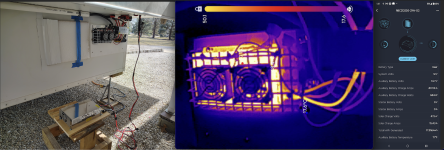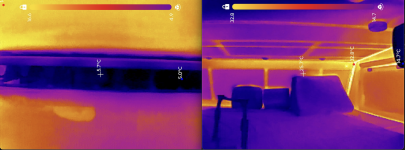-The biggest mod is redoing the electrical situation and fitting 2x300+ Ahr LiFePO4 batteries and installing a 12V mini split unit. This turned out to require an enormous amount of fussing around... I still need to finish the electrical system (new waterproof external mounted DC-DC charger + MPPT charge controller and fuses/bus bars) for this but its winter now and I'm gonna wait until warmer weather comes around again.
Getting itchy for the upcoming Spring 2025 trip out West.
Thought I should probably update things in case anyone is interested.
The new electrical modifications and the 12V DC minisplit worked great on my Spring trip to Utah and northern Arizona/New Mexico. I can also close off the sleeping area with the factory curtain and just cool that tiny area which radically reduces cooling energy requirements. I used the unit a few times on this trip in the heat of the afternoons, but it was never really gross temps. See below for some testing data in really gross hot/humid conditions.
The Renogy IP67 50A DC/DC charger with MPPT that I went with so I could move it outside the rig to make space for the 2x300+ Ahr batteries took some extra fussing around to keep it from getting extremely hot. During the winter when I was testing it I found it would get up to over 190F before it started derating current to protect itself. This seemed way too hot... went back and forth with Renogy and they at first thought that was also too hot. They ended up replacing my first unit, but the 2nd performed exactly the same. They eventually said that was the way this version was supposed to behave. I didn't like that so I added my own waterproof cooling fans and thermal switches to engage external cooling to keep it at reasonable temps... see pics below. When charging at 50 amps while driving fast the fans don't engage as there is enough wind to keep it cool. When driving slow on bumpy back country roads, however, the charger gets hot enough where the fans engage. I also bought and wired up a 48V DC 1000 watt power supply I can connect to the solar input to get 50 amps of charging when parked somewhere that has an electrical connection. The factory converter is limited to 30A which isn't enough to keep the batteries topped off if running the minisplit on max mode... so this way I have more than enough charging capability to run all the systems "just in case".
Back to the minisplit... Yesterday was the first really hot/humid gross temps we've had and I did a 24 hr test to see how well the 12V DC minisplit worked for cooling the rig and also to gauge how much battery capacity it would draw in these kind of conditions. We had heat indices of 105F with dew points in the upper 70's for this test. It was full sun and the rig was out in direct sun getting baked during the test. Since I removed the roof top 120V AC unit this Spring before the trip I was really hoping it would be capable. Turns out that even on Eco Mode its more than enough to cool the little camper. And it also has the benefit of removing all that weight from the roof.
The thermal image of the camper insides at the front of the rig where the afternoon sun was baking the rig shows that the insulation of the camper could be improved...
When the minisplit was set to 20.5C it had no problems holding the inside temp back by the fridge wall area at 71F the entire time (it varied from 70.5 to 71.4F throughout the test when I came in to record conditions but I just rounded it to 71F). I'm quite pleased with how well this $429 ebay purchase works. Although if I knew ahead of time how much fussing around it was going to take to do all these modifications I might have just muddled thru without it.




